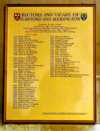For this church:    |
Ruddington St PeterList of Incumbents
At the north west end of the central aisle is a roll bearing the list of Patrons, Rectors and Vicars of Flawforth and Ruddington (A rector and resident in Ruddington appointed a vicar [vicorius = deputy] to serve in his place). It was dedicated in March 1981 in memory of churchwardens Edgar Stevenson and John Bargh, who died tragically in 1979 and 1980 respectively. The first rector listed, Ralph Barry dates from 1293. The lack of a vicarage and the poverty of the living is said to have made it difficult to appoint and retain a priest. To a large extent the community’s tithes, paid in kind, for example, hay, pigs, bees, eggs and corn helped. Some later priests were pluralists, for example, Francis Simes vicar in 1798 also held the benefices of Bunny and Plumtree. In the seventeenth century when England was a republic under the protectorship of Oliver Cromwell, Puritanism had an impact on all church livings. Francis Carrington (1638) had been a loyal Royalist and supporter of Charles I. He was unable to accept Puritan dogma and practices and was forced out, to be replaced by Henry Bee in 1652, a sound Puritan intended to bring the church into line. In 1654 Joseph Truman, a Puritan scholar, was appointed, probably until 1656 when the turbulence of the period led to a seven-year interregnum. Hugh Barlow was appointed the first schoolmaster of the Free School for children in the village later in the century. There is no record of his ordination; he probably acted as vicar. In the Nottinghamshire Archives a folder of miscellaneous documents dated 1867 in the time of Henry Bell includes an incomplete list of Ruddington incumbents from 1650. It begins with the statement that it is ‘necessary to pass over the first three pages’, one reason being the peculiar style of the various writings. Hugh Barlow is the first name recorded. What is interesting is a few potted biographies, for example William Bayley Cocker (1801) was born in Nova Scotia where his father was serving in the British Army. Cocker himself was in the army for a short period. As a pluralist, he was responsible for Ruddington and Bunny, and although he died in Cheltenham in 1823, he, his wife and daughter were buried in a vault at Bunny. Edward Selwyn, who succeeded him in 1823, was born in Gloucester in 1793, and also had army experience. He served in the Canadian wars 1812, 1813 after receiving a military education in Marlow. He died in Huntingdonshire in 1867 after 15 years in Ruddington. Later in the nineteenth century, it is recorded that the incumbent in 1878, Henry Telford Hayman, was known as Friar Tuck, being Chaplain of the Sherwood Foresters! Frank Potts is commemorated in the twentieth century by the clock face on the church tower facing Easthorpe Street being erected in his memory. He died in 1951 after twenty years in the parish. The updated list of incumbents reads as follows:
| ||||||||||||||||||||||||||||||||||||||||||||||||||||||||||||||||||||||||||||||||||||||||||||||||||||||||||||||||||||||||||||||||||||||||||||||||||||||||||||||||||||||||||||||||||||||||||||||||||||||||||






